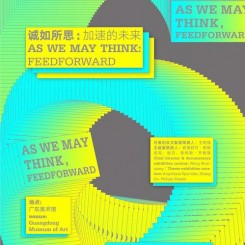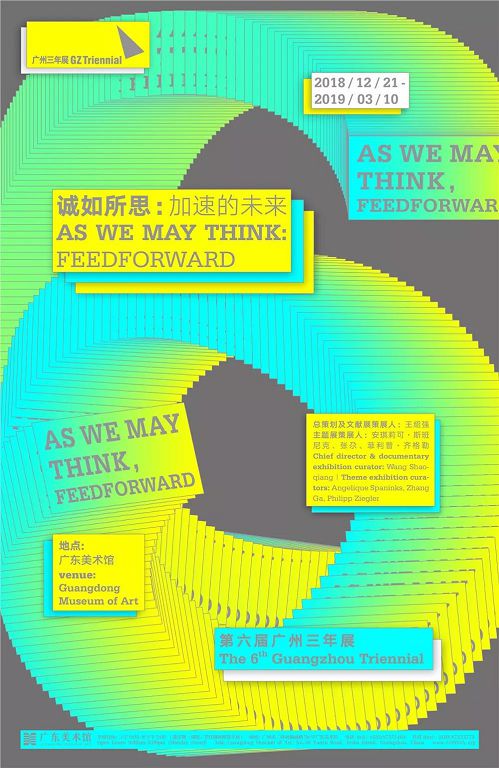[Press Release]
As We May Think: Feedforward
The 6th Guangzhou Triennial 2018
Guangdong Museum of Art
Dec 21,2018 – March 10, 2019
Chief director: WANG Shaoqiang
Theme Exhibition
Curators: Angelique Spaninks, ZHANG Ga, Philipp Ziegler
Triennial Archive Exhibition
Curator: WANG Shaoqiang
Theme Exhibition
As We May Think: Feedforward
“Consider a future device … in which an individual stores all his books, records, and communications, and which is mechanized so that it may be consulted with exceeding speed and flexibility. It is an enlarged intimate supplement to his memory.”
Vannevar Bush
In the summer of 1945, the American engineer Vannevar Bush published an essay in the Boston based journal The Atlantic. Titled “As We May Think,” the paper imagined a universal communications apparatus, which anticipated the advent of an information society. Over the last three-quarters of a century, what was then thought about by an insightful individual, who was able to think beyond the limits of his time, has materialized itself as a new world order in which the once dreamed-up Memex has not only taken on a much more powerful incarnation but also evolved, multiplied and accelerated into a pervasive, all-encompassing membrane of connected machines that operate on a planetary scale, giving rise to the unprecedented transformations that have forever redefined contemporary notions of work and play, politics and economics, culture, or life as a whole. Today with Moore’s law seeing no sign of slowing down and technological breakthroughs accelerating each passing day, along with the irrevocable encroachment of the Anthropocene, what can yet be thought of by human ingenuity and what is yet to be imagined through human fantasy demand a thinking beyond the very capacity of human herself as the cultural theorist Vilém Flusser once implicated “The imagination of human authors is nothing compared to the fertile imagination of chemistry,” here one might well substitute neural networks for the Flusserian chemistry. As existence has become aleatory and liminal at its core when change remains the only constant, a new reality descends in which future looms large with no certain destiny.
Titled As We May Think, Feedforward, extending this seminal text’s far-reaching ramifications into the artistic domain as a way to reflect on the trajectories of technological advances and their reverberations throughout the social sphere over the past decades, the 6th edition of Guangzhou Triennial seeks to address the multiple implications engendered by such a technologically constructed time-space – in the real and through the virtual – by examining creative endeavors both from geographical purviews and from cosmic prospects in responding to the challenges and opportunities at stake and to think, once again, through a new alliance of visions by humans and nonhumans alike, machines and flesh with equal footing, organic and inorganic hand in hand, an alternative outlook for a new possibility of ecology whereby a retooled humanism may thrive in a Parliament of Things (to borrow a term from Bruno Latour) in symbiosis and reciprocity.
The Triennial Theme Exhibition is organized in three parts each addressing a particular focus in question. Together they weave a web of interconnected entry points and exits, underlining a network of facticity and speculations that encapsulate the world as we know it now through imaginative impulse, and as we may think it once again by an unfettered vision to grasp a fleeting future.
Curators: Angelique Spaninks, ZHANG Ga, Philipp Ziegler
Part I
Inside the Stack: Art in the Digital
Curator: Philipp Ziegler
Artists from around the world are dealing with the growing presence of the digital and its impact on society. As we may think will show new perspectives on digital technologies, the Internet and social networks and examine both the virtual and physical manifestations of today’s artistic practice fundamentally influenced by the digital. The “digital age” has changed our thinking, acting and feeling rapidly since its appearance less than twenty years ago; when the global amount of digitally stored information surpassed that of analog for the first time. All areas of our everyday life, our perception and knowledge production are digitally engendered today. The digital is therefore today the predominant cultural technique in our “globally networked society, in which the biosphere and infosphere permeate and condition each other” (Peter Weibel). In their works, the artists brought together for this part of the Triennial take different perspectives on the digital that underlies their works as an “a priori”. Employing Benjamin Bratton’s concept of “the Stack” as a symbolic as well as a structural framework, Inside the Stack: Art in the Digital raises the very fundamental question of the digital as a new type of reality which reshapes contemporary experiences, and artists’ creative responses towards this reality.
Inside the Stack: Art in the Digital will take a look back on the history of the development of computer technology until today, provide an insight into digital infrastructures and the penetration of the real with the digital in our present and give a speculative outlook on technological developments of the digital in the future.
Part II
Evolutions of Kin
Curator: Angelique Spaninks
What does it mean to consider life equal for humans and non-humans alike – to witness evolution in everything in and around us, above and below, on nanoscale and in the universe, in past and future but most of all in the present? These are fundamental philosophical questions raised in the face of our ever emerging and accelerating technologies, in the digital as well as in the biological. Many of the artists in ‘Evolutions of Kin’ are doing exactly this: seeing and creating, researching, imagining and speculating on what others there may be – human and nonhuman. They question what it means to be human by incorporating the nonhuman, they design evolutions of kin, they swim the oceans of life and feed on the compost of time as crossbred and diverged species. And by doing so they create a sense of kinship, of ‘humankind’, as Timothy Morton calls it in his latest book, which makes it possible, for themselves and others, for better and for worse, to embody solidarity with the world as a whole.
Evolutions of Kin takes technological invention and intervention to an ethical level of inquiry, extending subjectivity to the nonhuman life, advocating a shared origin and co-evolutional trajectory of humans and nonhumans and a new vision of life.
Part III
Machines Are Not Alone
Curator: ZHANG Ga
The world is machinic: not only does its function depend on network of machines but also the land, river, mountains, trees and animals, humans included, are machines of some sort when seen from an operational point of view or an abstract sense of the word because they are systems of interconnected biospheres, neural synapses, motor-sensor coordinates, psychosomatic attributes, social relationships and technical milieus imbricated, intertwined, transversal and reciprocal as intricate as the relationship between humans and thoughts, knowledge and freedom. Far from a mechanistic vision of dualism, this worldview of machines, apparatuses and devices is one that envisages a unity which endorses giving everything its due place as equally significant and worthy with respect and care.
The exhibition Machines Are Not Alone fitted with cloud machines, earth machines, and many other geoengineering and emotive devices and apparatuses, moved by transportation machines and custom machines and activated by exhibition machines, workshop machines and audience and participation machines will have a three-part journey to complete its global treading. It starts its ignition at Chronus Art Center in Shanghai in the summer of 2018, continues to Zagreb Contemporary Art Museum in winter, and finally culminates at the Guangzhou Museum of Art as a component of 6th Guangzhou Triennial. Each traveling iteration will root itself in the local milieu with a cosmic outlook and create interconnections with its immediate surroundings and umwelt logistically, ecologically and psychosocially as if a living act of the Three Ecologies. Together the trilogy maps out a machinic trajectory that transverses oceans and lands, places and sites; integrates climates and communities and adapts limitations and expansions for a resounding machinic chorus.
Machines Are Not Alone further extends the notion of subjectivity into the realm of nonlife and the object world, both cultural and natural, technology and psychic, proposing a radical rethinking of modernity, freedom and emancipation in a posthuman symbiosis.
- Thomas Bayrle(Germany)
- Zach Blas & Jemima Wyman(America / Australia)
- Melanie Bonajo (the Netherlands)
- Tega Brain(Australia)
- Emma Charles (the United Kingdom)
- 邓悦君/Deng Yuejun(China)
- Simon Denny (New Zealand)
- Anna Dumitriu (the United Kingdom)
- Gilberto Esparza (Mexico)
- Harun Farocki (Germany)
- 冯晨/Feng Chen(China)
- Thomas Feuerstein (Austria)
- Dorian Gaudin (France/America)
- 关小/Guan Xiao (China)
- Heather Dewey-Hagborg (America)
- Femke Herregraven(the Netherlands)
- Arne Hendriks (the Netherlands)
- Pierre Huyghe(France)
- Charlotte Jarvis (the United Kingdom)
- Arvid Jense & Marie Caye (the Netherlands)
- 蒋竹韵/Jiang Zhuyun(China)
- Delia Jurgend (Germany)
- Floris Kaayk (the Netherlands)
- Jon Kessler(America)
- Oliver Laric (Austria)
- Lynn Hershman-Leeson (America)
- Lawrence Lek(the United Kingdom)
- 刘佳玉/Liu Jiayu(China)
- 林科/Lin Ke(China)
- Bernd Lintermann(Germany)
- 刘娃/Liu Wa(China)
- 陆平原/Lu Pingyuan(China)
- Bernie Lubell(America)
- MacGuffin (the Netherlands)
- Simone C. Niquille (the Netherlands/Switzerland)
-
David OReilly
- Tabita Rezaire(France)
- Tomás Saraceno (Argentina)
- Fito Segerera (Columbia/China)
- 沈瑞筠/Shen Ruijun(China)
- Ief Spincemaille(Belgium)
- Unknown Fields(England / Australia)
- Addie Wagenknecht (America)
- 王楠/Wang Nan(China)
- Herwig Weiser(Austria)
- 王郁洋/Wang Yuyang(China)
- 杨健/Yang Jian(China)
- 郑先喻 & 张硕尹/Zheng Xianyu & Zhang Shuoyin(Taiwan, China)
- 张永基 /Zhang Yongji (China)


